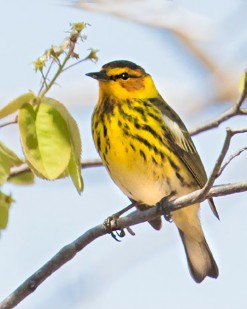Tom Aversa

Cape May Warbler. Photograph by Sandy Selesky.
On April 21, 2016 at approximately 10:30 am, while birding with my brother Steve at Hammock Park in Dunedin, Florida, I encountered a pair of Cape May Warblers (Setophaga tigrina). We easily identified the male by its black, finely-streaked bright yellow underparts, orangish face, and bold white wing patch. A nearby similarly shaped but much duller warbler proved to be a female Cape May. Both foraged in fairly close proximity within the crown of a live oak (Quercus virginiana). As we observed the birds, we noted that the male was carrying a food item. As they moved closer to each other, he approached the female and fed the unidentified invertebrate to her. I found this extremely surprising since I could not remember observing Neotropical wood-warblers engaging in courtship feeding during their migration.
On the next day while birding over 40 kilometers south of Dunedin at Fort De Soto Park in Pinellas County near St. Petersburg, we located another pair of Cape Mays. I was astonished to once again observe the brightly-plumaged male feed its female companion an unidentified invertebrate. This pair was foraging in mature slash pine (Pinus elliottii) near the Arrowhead Family Picnic Area of the park. Steve, as well as my sister Anne, also observed this incident.
In my search of the literature, I was unable to find any reference to wood-warblers courtship feeding on migration. This does not mean that it has never been observed, but perhaps only that no one had taken time to note it in a peer-reviewed journal. Dunn and Garrett (1997) report that male migratory wood-warblers arrive about a week earlier to the breeding grounds than the females in order to claim territory and defend it from other males. In migration, many wood-warbler species are found in mixed-species flocks, primarily consisting of other wood-warblers. In some Setophaga, when more than one individual of a species is present within a flock, aggressive interactions between the conspecifics are frequently observed. Despite this, it is possible that in some cases at least, wood-warblers might pair on migration or even on their wintering grounds and move together to the northern breeding grounds. Greenberg and Gradwohl (1980) reported observing pairs of Canada Warblers (Cardellina canadensis) in mixed flocks in Panama. Most Cape Mays winter in the Caribbean (Baltz and Latta 1998), so it seems plausible that the migrants that we observed may have made the ocean crossing together while utilizing the easterly airflows that were present for several days before and throughout the days of my observations.
Other groups of Neotropical migrants such as grosbeaks, buntings, tanagers and orioles are often observed in mixed sex flocks, and pairs may migrate together. Wyatt and Francis (2002) reported that Rose-breasted Grosbeaks (Pheucticus ludovicianus) are more gregarious during migration but that male arrival dates at breeding sites average earlier than that of the females. Moore, Kerlinger, and Simons (1990) observed similar arrival date patterns for grosbeaks at a stopover site on the Mississippi coast.
Lack (1940) pointed out that the primary purpose of courtship feeding in birds, which perform this act previous to incubation, is not to provide extra nutrition. Instead the symbolic act presumably maintains and strengthens the bond between the pair. The action provides information to the female that allows her to gauge the prospective fitness of a male as a future food provider during incubation and the period when the two share feeding duties of the young. Royama (1966), however, emphasized that courtship feeding also provides important additional nutrition to female birds on the breeding grounds. He observed Great Tits (Parus major) in Japan and European Blue Tits (then Parus caeruleus, now Cyanistes caeruleus) in England and showed that the frequency of courtship feeding greatly increased just before and during the egg-laying period. He concluded that this showed that the predominant purpose of the behavior was to provide extra nutrition.
It seems far more likely that the symbolic importance of the act for pair bonding explains courtship feeding by Cape May Warblers in Florida, but it cannot be ruled out that the extra nutrition might increase the female’s chance of arriving in the boreal forest in prime condition to begin the rigorous process of egg-laying. This would only make evolutionary sense if the pair bond is subsequently maintained throughout the migration period. Perhaps the lack of reported observations of courtship feeding along more northerly segments of their migration route also make Royama’s explanation less likely.
The purpose of this note is to encourage others to watch for and note observed courtship feeding during migration. Because I observed the behavior on subsequent days at different locations, it seems likely that it occurs more frequently than it is reported.
References
- Baltz, M. E. and S. C. Latta. 1998. Cape May Warbler (Setophaga tigrina) in The Birds of North America Online (A. Poole, Ed.). Ithaca: Cornell Lab of Ornithology.
- Dunn J. L. and K. L. Garrett. 1997. A Field Guide to the Warblers of North America. Boston: Houghton Mifflin.
- Greenberg, R. S. and J. A. Gradwohl. 1980. Observations of paired Canada Warblers Wilsonia canadensis during migration in Panama, Ibis 122 (4): 509-512.
- Lack, D. 1940. Courtship feeding in birds, Auk 57 (2): 169-178.
- Moore, F. R., P. Kerlinger, and T. R. Simons. 1990. Stopover on a Gulf coast barrier island by spring trans-gulf migrants, Wilson Bulletin 102 (3): 487-500.
- Royama, T. 1966. A re-interpretation of courtship feeding, Bird Study 13 (2): 116-129. Accessed on 30 July, 2016.
- Wyatt, V. E. and C. M. Francis. 2002. Rose-breasted Grosbeak (Pheucticus ludovicianus) in The Birds of North America Online (A. Poole, Ed.). Ithaca: Cornell Lab of Ornithology.